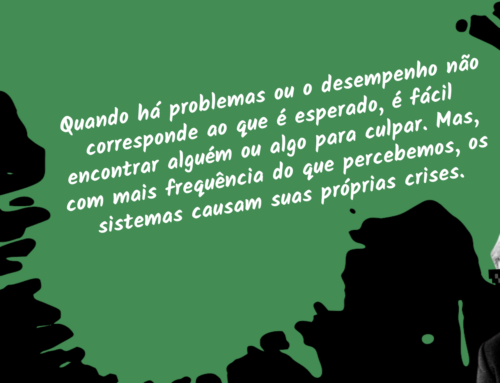It is not enough to develop new products and invest in innovation, it is necessary to overcome organizational inertia.
Everyone knows Netflix well. Everyone over 21 remembers Blockbuster. Now I do not know if everyone can answer correctly:
- Who had the first website, Blockbuster or Netflix?
- Who was the first to rent movies (still DVDs) through the website, Blockbuster or Netflix?
- Who was the first to experiment with streaming movies, Blockbuster or Netflix?
- Who went bankrupt, Blockbuster or Netflix?
The answer to the four questions is “Blockbuster.”
Now look at this sequence of events between the years 1975 and 2012:
- 1975 – Steven Sasson working for Kodak developed the first digital camera.
- 1981 – Sony introduced the first version of Mavica, which recorded up to 50 photos of 0.3 megapixels to be shown on a TV or printed.
- 1991 – Kodak launches its first digital camera to the market. Made especially for photojournalism, the DSC had 1.3 megapixels.
- 1994 – Apple introduces the first digital camera that achieves great sales success. Quicktake was produced by Kodak, but it didn’t carry its mark.
- 2001 – First drop in Kodak’s film sales, executives blame the September 11th attacks and decide to invest in marketing to keep the public from migrating to digital.
- 2010 – Losing market share year after year, Kodak ranks 7th in the US digital camera market.
- 2012 – Kodak goes bankrupt and announces that it will not produce more digital cameras.
These and other large companies suffered from what we call organizational inertia.
Great teams, plenty of capital and a lot of capacity for new product development and innovation. Even with all this, these organizations had great inertia. They were true transatlantic ships at high speed, which to change course 180° need a lot of time and effort. In their case, time was up before the turn.
We can cite four factors that generate organizational inertia and ways of minimizing them:
1. Successful Past
The more profit, results and fame an organization achieves, the more it crystallizes mindsets, business models and a wide range of cultural attributes. The old adage prevails “if it ain’t broke, don’t fix it”. It makes no sense to avoid success, but it is important to be aware of our biases and to work proportionately on other factors.
One of the most common strategies is to create or buy another company or organization with the maximum autonomy to follow the new course. However, for me this does not constitute a decrease in inertia, but a way to avoid a possible corrosion of shareholders’ capital. I find it innocent to think that this new small business can significantly influence the great and glorious past. But who knows…
2. Silos and Office Politics
Traditional structures that make use of the chain of command naturally create silos. When we work in an team or department ,we grow our affection and identification with the people around us. A team feeling is born, which, while helping to motivate, creates a silo. This phenomenon strengthens resistance to change, as it is often a threat to the power and identity of the group.
In addition, managers contribute a lot to the consolidation of silos, by building the concept of “my team” that needs to be protected and valued in front of other company teams. Add to this the fact that even with the hierarchy of power, there is a parallel political game that can be very strong. Even coming to the point of sabotaging or blocking the CEO’s attempts to promote the change.
Creating a culture with little silo formation that minimizes office politics is not a simple task, especially when an organization grows above 150 people (Dunbar’s number). A great lever available is the adoption of a highly flexible organizational structure such as Holacracy. In addition to dissolving the concept of departments, it distributes authority explicitly, which directly attacks the political game.
3. Focus on the core and the short term
If you focus on the “core business” and deliver results in the short to medium term, you’ll never stop selling books online to become one of the largest cloud computing retailers and providers in the world (obviously, I’m talking about Amazon).
Kodak was addicted to the profits from the sale of photographic films. Blockbuster could not give up the revenue from the “late fees” they applied to those who did not deliver the film on time.
Instead of focusing on the core, focus on the purpose. You need to have a clear purpose and that is not restricted to the generation of dividends for the shareholder. Especially when this shareholder only thinks about the short term. It is much easier to change your business model when its purpose is powerful and shared by everyone in the organization. Want to know how to write an incredible purpose? Look here.
4. Low situational awareness
If you still use the SWOT matrix to build a detailed strategic plan that equates to building the Death Star in the next 5 years, maybe it’s time for you to think again about how you deal with strategy in your organization.
By playing Nostradamus we fail to focus on the present situation, in the futile attempt to guess the future. We need to better understand the present scenario and imagine possible trends, creating a vocabulary and a conversation within the organization about the possible directions. More than detailed action plans, we need to have clarity of priorities and encourage recurrent and frank conversations on the way ahead.
If your company has a “strategy statement” picture on the wall, look for vague words and buzzwords. If what is written looks like what is automatically generated by this website, it is a sign that there is no shared understanding of the scenario or what is a priority.
It takes a constant effort that can’t be replaced by grandiose plans made annually or by a strategic consultant that gives recipes. Using tools specifically for this purpose such as Wardley Maps may work.
The Blockbuster and Kodak examples serve as an alert. They did experiments and mastered the technology that years later would be adopted by millions of people. Their failures are there to remind organizations of all sizes that inertia is something real and that can immobilize even the innovator and market leader. Tailor your organization before it’s too late. We at Target Teal can assist you in this process. Let’s talk?






[…] Do you really believe that tools that use simple 2×2 tables like the BCG matrix account for the complexity and ambiguity of their context? In SWOT have you realized that almost all elements that are weaknesses and threats can also be seen as opportunities? Have you ever thought that for example the great strength of Blockbuster was its large and wide network of stores and the great physical catalog? All of this quickly lost its meaning in the era of streaming. RIP Blockbuster. […]
[…] understand that this change may not be so simple, especially when organizational design and culture create barriers to change. That is why we need to work in an integrated way on the other 3 […]
[…] the pace of external change and the speed of adaptation of companies and organizations. Nokia, Kodak and Blockbuster are good […]